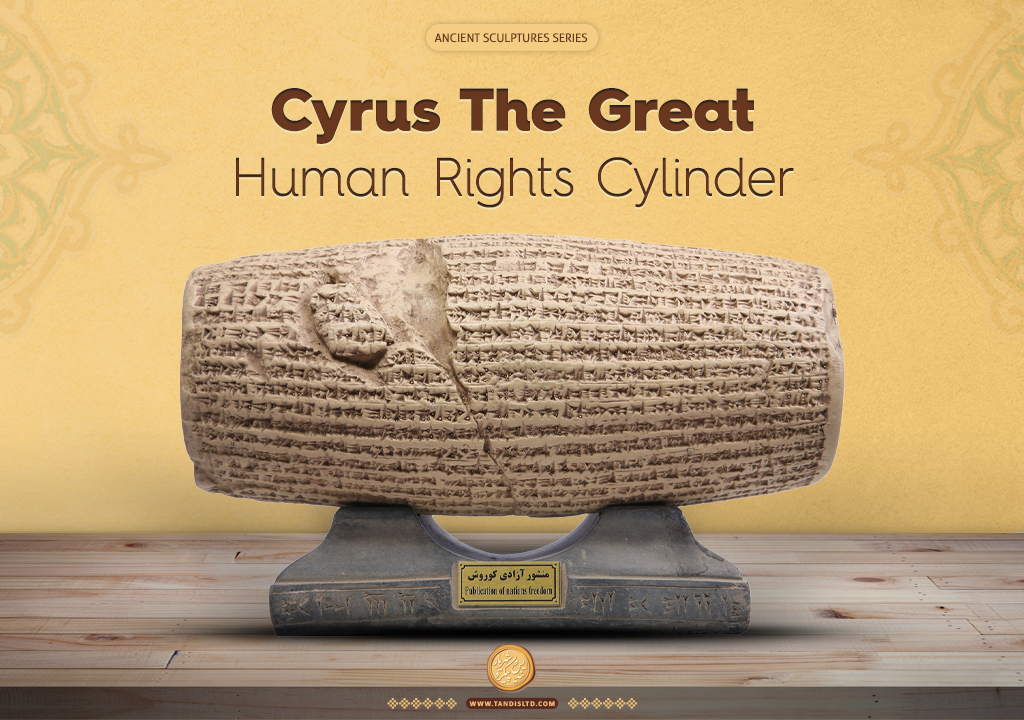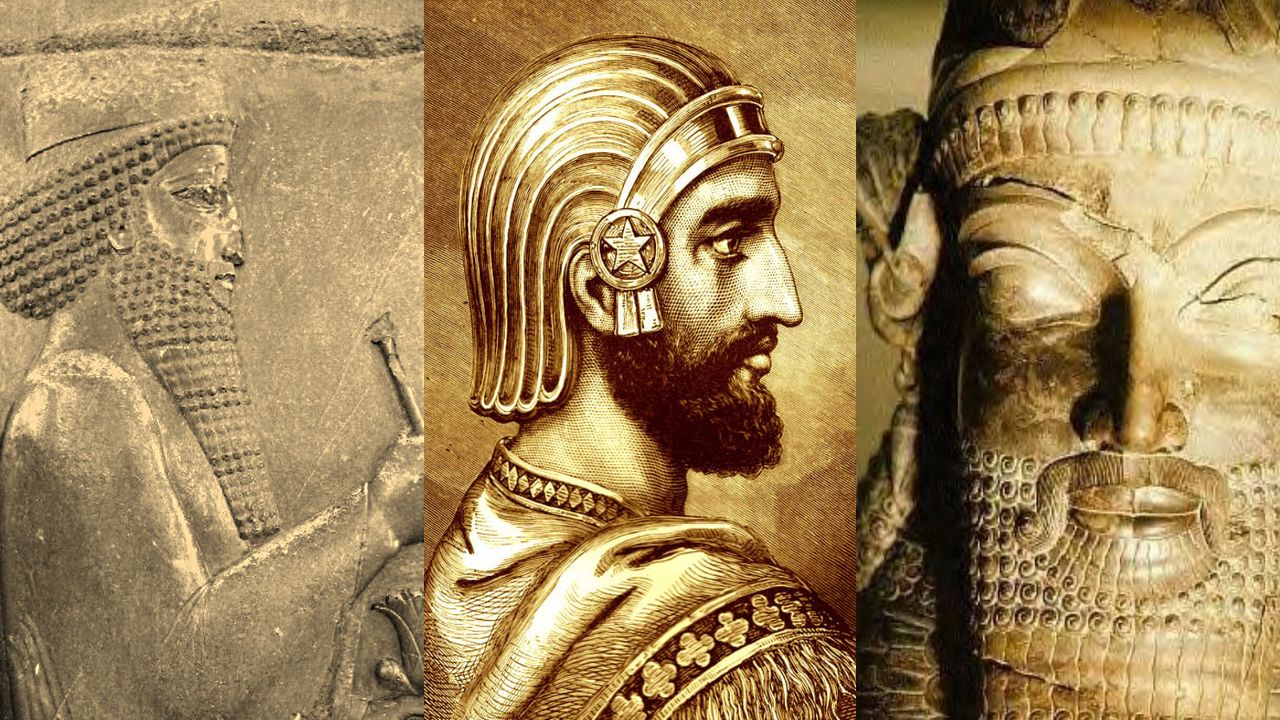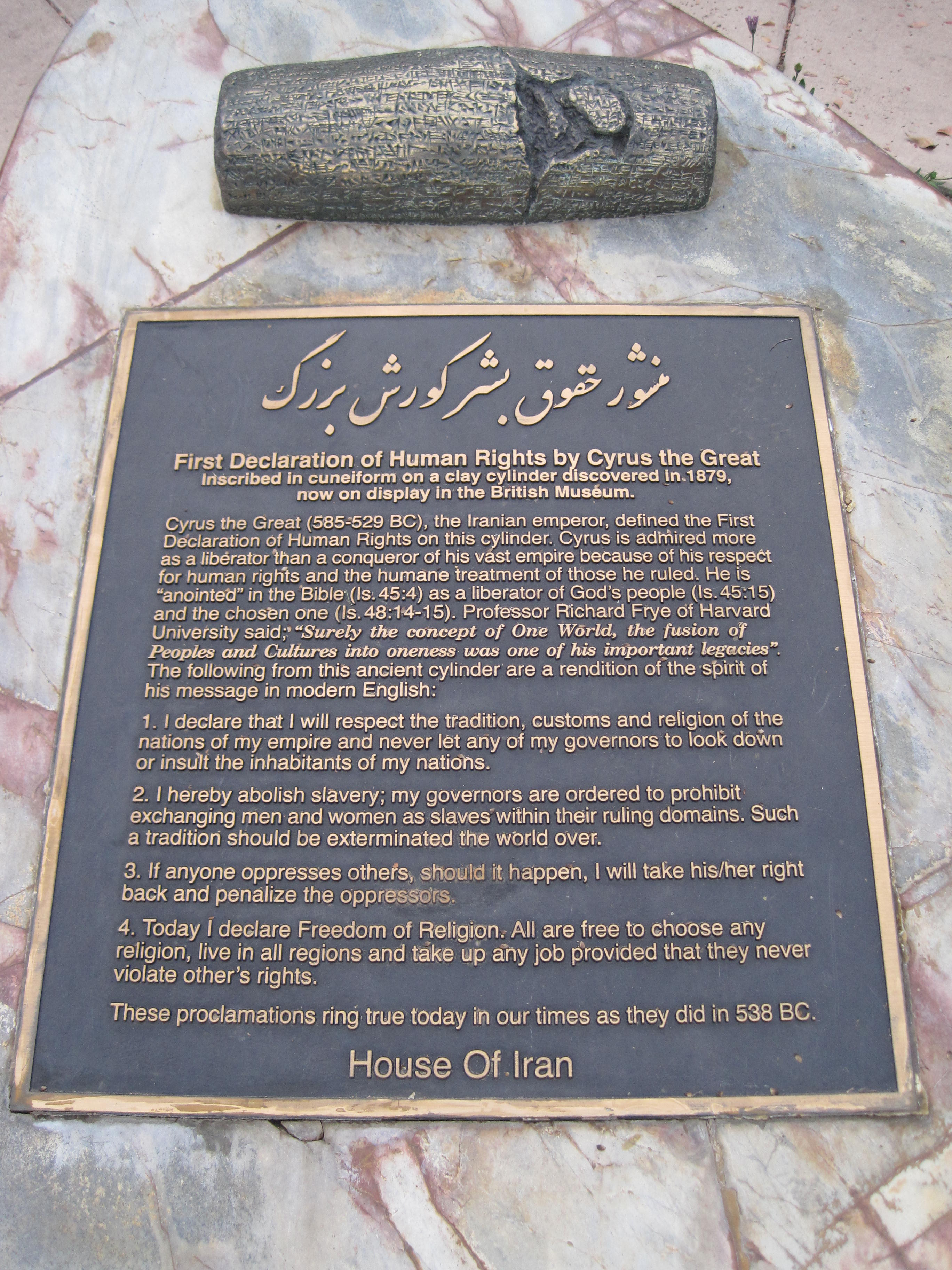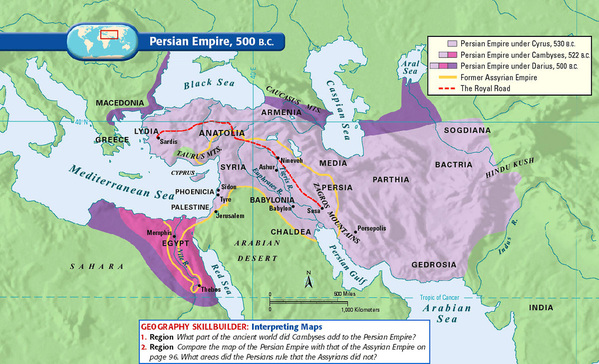First posted on 20 March 2013, updated on 2 August 2024
A Vision for a Troubled World, a World in Pain and Agony
Let the Cyrus Cylinder Shine Light and Hope in the Darkness Again

The Cyrus the Great Cylinder is the first charter of right of nations in the world. It is a baked-clay cyliner in Akkadian language with cuneiform script. This cylinder was excavated in 1879 by the Assyro-British archaeologist Hormuzd Rassam in the foundations of the Esagila (the Marduk temple of Babylon) and is kept today in the British Museum in London.
The Cyrus Cylinder: Ancient Persia’s Gift to the World
There can be no Peace without Justice, Human Dignity, Humility and the life-affirming Reverence for Life.
In Civilization and Ethics, Albert Schweitzer has reminded us that: Ethics is nothing other than Reverence for Life. Reverence for Life affords us our fundamental principle of morality, namely, that good consists in maintaining, assisting and enhancing life, and to destroy, to harm or to hinder life is evil.
by Kamran Mofid, Ph.D. (ECON)
It is with horror and absolute sadness that we are all witnessing the children of Abraham tearing each other apart in the Middle East. This is an untold tragedy with immeasurable tragic consequences for all. Many sages and saints have reminded us that war is not the answer. There will be no winners, only losers. Bombs, missiles, rockets, and drones; destruction of bridges, buildings, roads, houses, schools and hospitals, killing of the innocents on all sides, will not bring peace. If these actions were instruments of peacebuilding and peacemaking, then, by now, we should have created paradise on earth, given the number of wars and the consequent destruction that we have had in the past. Indeed, the twentieth century was the bloodiest in human history, with holocausts, genocides, ethnic cleansings, two world wars, and hundreds of inter and intra-national wars.
Now, if war is not the answer, then what is?
I wish to offer the Cyrus Cylinder as a timeless charter for peace with justice and dignity. As long as there is no compassion and no justice in international relations and in human relationships, there will be more horrific wars, and no amount of force and the usage of weapons of mass destruction can bring about a peaceful world. Peace starts with us, its true force is in our hearts, and its real instrument is called love, justice and compassion; our journey for the common good, if you will. Lucky are those who discover and understand this and pity those who fool themselves thinking otherwise.
'The Cyrus Cylinder is one of the most famous objects to have survived from the ancient world. Inscribed in Babylonian cuneiform on the orders of the Persian King Cyrus the Great (559-530BC) after he captured Babylon, it is often referred to as the first bill of human rights, as it appears to permit freedom of worship throughout the Persian Empire and to allow deported people to return to their homelands. It is a valued object by people all around the world as a symbol of tolerance and respect for different peoples and different faiths, which is why a copy of the cylinder is on display in the United Nations building in New York...You could almost say that the Cyrus Cylinder is a history of the Middle East in one object and it is a link to a past which we all share and to a key moment in history that has shaped the world around us.’ - Neil MacGregor, Director of the British Museum

Cyrus the Great: King of the Persian Empire. Photo: bing.com
‘Among his many achievements, this great leader of wisdom and virtue founded and extended the Persian Empire; conquered Babylon; freed 40,000 Jews from captivity; wrote mankind's first human rights charter; and ruled over those he had conquered with respect and benevolence…As a result the Iranians regarded him as "The Father," the Babylonians as "The Liberator," the Greeks as the "Law-Giver," and the Jews as the "Anointed of the Lord."-Larry Hendrick
‘His policies included freedom of religion, equality of wages, and freedom of speech. His cultural and societal activities set in motion what we know today as human rights. The Declaration of Independence of the United States of America incorporates the major points Cyrus II of Persia focused on during his reign.’- Billy Wellman and Enthralling History
( March 2013) The Cyrus Cylinder has left its British Museum repository for its first U.S. tour, beginning at the Smithsonian Institution’s Arthur M. Sackler Gallery in Washington. “The Cyrus Cylinder and Ancient Persia” showcases this 2,600-year-old archeological treasure amid other artifacts from the Achaemenid Empire (550–331 B.C.) founded by the Persian ruler Cyrus the Great.
The Cyrus Cylinder

"The Cyrus the Great Cylinder is the first charter of right of nations in the world. It is a baked-clay cyliner in Akkadian language with cuneiform script. In 1971, the Cyrus Cylinder was described as the world’s first charter of human rights and it was translated into all six official U.N. languages. A replica of the cylinder is kept at the United Nations Headquarters in New York City in the second floor hallway, between the Security Council and the Economic and Social Council chambers. Passages in the text of cylinder have been interpreted as expressing Cyrus’ respect for humanity, and as promoting a form of religious tolerance and freedom; and as result of his generous and humane policies, Cyrus gained the overwhelming support of his subjects."
Among the most important objects in world history, the cylinder “in its time declared a new way of ruling in which disparate races and people were not oppressed into conformity but respected for diversity”.
According to the British Museum Director, Neil MacGregor, “Unlike ancient Chinese and Egyptians, who wrote much about what they did and how well they did it, the Persians just did it. They don’t write about how they did it. They left no memoirs” about their great lives and times. We know what happened from Greek and Jewish sources.
The Cyrus Cylinder has special significance to Jews, because it alludes to their return to Jerusalem, which is supported by biblical references. In the Book of Isaiah (44:28), God says of Cyrus, “He is my shepherd and will accomplish all that I please; he will say of Jerusalem, Let it be rebuilt, and of the temple, Let its foundations be laid,” and goes on to call Cyrus “anointed” by God. Other references may be found in 2 Chronicles and the Book of Ezra.
Jews on the Map of History
Cyrus’s actions had particularly momentous consequences for one group of exiles in Babylon: the Jews.
Though the Cylinder does not mention the Jews by name, it echoes Cyrus’s biblical edict that exhorted the Jewish people to return to Jerusalem and rebuild their temple. Had Cyrus not freed the peoples of Babylon, said Bible historian Dr. Tamara Cohn Eskenazi, “the exiled Jews would probably have disappeared from the map of history, the way so many other peoples from the biblical period disappeared.”-Why the Cyrus Cylinder Matters Today
The values articulated by Cyrus influenced Europe and the United States, conveyed there by Classical Greek writers Herodotus and Xenophon, admirers of Cyrus’ leadership. Xenophon’s Cyropaedia, a partly fictional account of the ruler’s life, was read by the Founders of the United States, including Thomas Jefferson and Benjamin Franklin. Jefferson is thought to have possessed two copies, one of which is on display in the current exhibit at the Sackler Gallery. “Only the United States takes up the Persian model,”: “Jefferson constructs a state … which supports the idea of faith but doesn’t endorse any particular one.”-2,600-year-old Cyrus Cylinder still relevant
Learn more about Persian Civilisation and the Modern Iran

‘The Persian Empire was located in present day Iran, and was based on tolerance and diplomacy. Before the Persians rose to power several small kingdoms occupied the region. Out of those regions the Medes and the Persians were the strongest, and eventually would become great rivals. At the head of the Persian Empire was King Cyrus. Cyrus was a military genius, and expanded his empire by conquering the small neighboring kingdoms that surrounded his land in 550 BC. By conquering these small kingdoms with his strong military, Cyrus gained the Persians attention from nearby empires. But Cyrus wasn't like most conquers, whenever the Persians conquer a kingdom Cyrus didn't let his men loot or burn the towns. He also allowed the Jews to return to Jerusalem and under Persian rule the Jews rebuilt their city and temples. With Cyrus as their king the Persian Empire now spanned more than 2,000 miles and with their wealth in natural resources like gold, silver, copper, lead, and blue lapis, the Persians established a thriving trade system with partners from the east and west.'-The Empire
Cyropaedia of Xenophon; The Life of Cyrus The Great
Cyrus the Great; The decree of return for the Jews, 539 BCE
A Thousand Years of the Persian Book: A Curator's Tour
See also:
Zoroastrianism the ancient religion of Persia that has shaped the world
Oslo Accords, 30 Years on: Can there be Peace?

'The Cyrus Cylinder is one of the most famous objects to have survived from the ancient world. Inscribed in Babylonian cuneiform on the orders of the Persian King Cyrus the Great (559−530BC) after he captured Babylon, it is often referred to as the first bill of human rights, as it appears to permit freedom of worship throughout the Persian Empire and to allow deported people to return to their homelands. It is a valued object by people all around the world as a symbol of tolerance and respect for different peoples and different faiths, which is why a copy of the cylinder is on display in the United Nations building in New York. This lavishly illustrated catalogue is published to complement the first ever tour of the object to the United States, along with sixteen other objects from the British Museum’s world-famous collection. Including a new authoritative translation of the Cyrus Cylinder by Irving Finkel, The Cyrus Cylinder and Ancient Persia offers a fascinating introduction into a period of great social and political change in the Ancient Near East.. ‘You could almost say that the Cyrus Cylinder is a history of the Middle East in one object and it is a link to a past which we all share and to a key moment in history that has shaped the world around us.’ - Neil MacGregor, Director of the British Museum.'- Read more and buy the book HERE

'Cyrus, a great Persian leader, was so widely and memorably respected that a hundred years later, Xenophon of Athens wrote this admiring book about the greatest leader of his era. Larry Hedrick's Introduction describes Cyrus and his times.
Among his many achievements, this great leader of wisdom and virtue founded and extended the Persian Empire; conquered Babylon; freed 40,000 Jews from captivity; wrote mankind's first human rights charter; and ruled over those he had conquered with respect and benevolence.
According to historian Will Durant, Cyrus the Great's military enemies knew that he was lenient, and they did not fight him with that desperate courage which men show when their only choice is "to kill or die." As a result the Iranians regarded him as "The Father," the Babylonians as "The Liberator," the Greeks as the "Law-Giver," and the Jews as the "Anointed of the Lord."
By freshening the voice, style and diction of Cyrus, Larry Hedrick has created a more contemporary Cyrus. A new generation of readers, including business executives and managers, military officers, and government officials, can now learn about and benefit from Cyrus the Great's extraordinary achievements, which exceeded all other leaders' throughout antiquity.'- Read more and buy the book HERE

'Cyrus the Great was a humanitarian, a diplomat, a military strategist, and a ruler of the largest empire the world had ever seen up to that point.
Cyrus the Great was a remarkable man who became a legend in his own lifetime. The greatest testament to his good character and great achievements came to us via Persia’s enemies: the Greeks. It is said he served as an inspiration to Alexander the Great and Julius Caesar. Cyrus gained such hero status that his heritage was still claimed by the last shahs of Iran in the 20th century CE.
His policies included freedom of religion, equality of wages, and freedom of speech. His cultural and societal activities set in motion what we know today as human rights. The Declaration of Independence of the United States of America incorporates the major points Cyrus II of Persia focused on during his reign...'-Read more and buy the book HERE

'The Persian Empire was the world's first hyperpower, with territory stretching from Central Asia to Northeastern Africa and from Southeastern Europe to the Indus Valley. It was the dominant geopolitical force from the later sixth century to its conquest by Alexander in the 330s BCE. Much of the empire's territory was conquered by its founder, Cyrus the Great, who reigned from 559-530 BCE. Cyrus became a legend in his own lifetime, and his career inspired keen interest from Persia's unruly neighbors to the west, the ancient Greeks. The idealized portrait of Cyrus by the Greek Xenophon had a profound impact on ancient, medieval, and early modern debates about rulership...'-Read more and buy the book HERE

'Cyrus the Great was one of the most influential figures in history- an enlightened ruler and brilliant general who created the Persian Empire, the largest empire known to man to that time...'-Read more and buy the book HERE

Introduction
'THE BooK you have in your hands, although having a geographical name in its title, is, in fact, the first chapter of the worldwide history of the Jews.Iran, according to the Bible and based on reliable historical facts, is the land from where the Israelites set out on the longest road ever known in the entire world: the road of the Diaspora. The borders of Iran during ancient times, when it was called the Persian Empire, extended far beyond its present-day frontiers. The first Jews were either exiled to or sought refuge in this large territory, which extended from Ethiopia to India and comprised r27 provinces, as the book of Ester indicates (r't-q).
One hundred thirty-four years before the destruction of the First Temple in 586 B.c.E., with the Assyrian onslaught to the north of the Holy Land, the ten lost tribes were forced to go to the east, toward Persia. Babylon, the former hub of Judaism, was an Iranian province for more than a thousand years, including the period during which the Talmud was written. Indeed, Iranian cultural influences are manifest in the Babylonian Talmud, which is, in essence, an "lranian Talmud."
Apart from Cyrus-the Iranian king referred to in the Torah as "God's anointed"- are many other biblical references to relations between Iran and Israel. Leaders and prophets, such as Ezra, Nehemiah, and Daniel, are testimony to the important role played by the Jews in Iran. The Jewish-Iranian queens, Esther and Shushandokht, and the Jewish grand viziers, Sa'd al-Dawlah and Rashid al-Din Fazlallah Hamadani, bespeak the influence of the Jewish community in Iran...'- Continue to read
